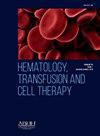CHARACTERISTICS OF HEMATOLOGICAL MANIFESTATIONS IN PATIENTS WITH SYSTEMIC LUPUS ERYTHEMATOSUS: SINGLE CENTER EXPERIENCE
IF 1.6
Q3 HEMATOLOGY
引用次数: 0
Abstract
Objective
Systemic Lupus Erythematosus (SLE) is an autoimmune disease that manifests with various organ involvement, including hematological involvement. The objective of this study was to examine the demographic and clinical information, as well as the hematological involvement characteristics, of SLE patients.
Methodology
The study was a single-center retrospective study. Patients with SLE who underwent complete follow-up visits were included in the study according to the classification criteria established by the American College of Rheumatology (ACR) and the Systemic Lupus International Cooperation Clinics (SLICC). A retrospective review of the patients' demographic and clinical information was conducted by examining the hospital's electronic record system. The clinical information, laboratory parameters, and SLE-specific treatments were documented. Patients were divided into sub-phenotypes according to organ involvement, and patients with hematologic involvement (anemia, leukopenia, thrombocytopenia, and splenomegaly) were identified. Statistical analyses were performed using SPSS version 26.0 (SPSS Inc., Chicago, IL, USA). The variables were calculated using visual (histogram and normality plots) and analytical methods (Kolmogorov-Smirnov) to determine whether they were normally distributed. Descriptive analysis was performed using mean ± Standard Deviation (SD) or median and Interquartile Range (IQR).
Results
The study included 302 patients with SLE, 87 (34.7.8%) of whom had hematological manifestations. The mean age at diagnosis was 36.4 (±9.8). 237 (78.7%) of these patients were female. Clinical manifestations were observed among the patients, including skin involvement in (54.3%), articular involvement (48%), renal involvement in (26%). The ANA test was positive in 96.2% of patients with hematologic involvement. In addition, 34.7% had high anti-dsDNA autoantibodies and 33% had low C3 levels. Anemia was the most common hematological abnormality, affecting 55.7% of patients. The mean hemoglobin value was 9.7 mg/dL. Autoimmune hemolytic anemia was seen in 13.2% of patients. Thrombocytopenia was present in 9.2% of patients, and leukopenia in 12.2%. 57 (18.8%) SLE patients had secondary antiphospholipid antibody syndrome. 76.8% of patients received glucocorticoids and 81% received hydroxychloroquine treatment. 41% of patients received at least one steroid-sparing agent, including azathioprine, cyclophosphamide, mycophenolate mofetil, and rituximab.
Conclusion
The hematologic manifestations of SLE should be evaluated and treated in order to provide a better outcome.
系统性红斑狼疮患者血液学表现的特点:单中心经验
目的系统性红斑狼疮(SLE)是一种自身免疫性疾病,表现为多种器官受累,包括血液系统受累。本研究的目的是检查SLE患者的人口学和临床信息,以及血液学受累特征。方法:本研究为单中心回顾性研究。根据美国风湿病学会(ACR)和系统性狼疮国际合作诊所(SLICC)制定的分类标准,将进行完整随访的SLE患者纳入研究。通过检查医院的电子记录系统,对患者的人口统计和临床信息进行了回顾性审查。记录临床信息、实验室参数和sle特异性治疗。根据受累器官将患者分为亚表型,并确定血液学受累患者(贫血、白细胞减少、血小板减少和脾肿大)。采用SPSS 26.0 (SPSS Inc., Chicago, IL, USA)进行统计分析。使用目测(直方图和正态图)和分析方法(Kolmogorov-Smirnov)计算变量,以确定它们是否正态分布。描述性分析采用均数±标准差(SD)或中位数和四分位间距(IQR)进行。结果本研究共纳入302例SLE患者,其中87例(34.7.8%)有血液学表现。平均诊断年龄为36.4岁(±9.8岁)。237例(78.7%)为女性。临床表现为皮肤受累(54.3%)、关节受累(48%)、肾脏受累(26%)。在血液学受累的患者中,96.2%的ANA检测呈阳性。此外,34.7%的患者抗dsdna自身抗体水平较高,33%的患者C3水平较低。贫血是最常见的血液学异常,占55.7%。平均血红蛋白值为9.7 mg/dL。13.2%的患者出现自身免疫性溶血性贫血。9.2%的患者存在血小板减少,12.2%的患者存在白细胞减少。57例(18.8%)SLE患者有继发性抗磷脂抗体综合征。76.8%的患者接受糖皮质激素治疗,81%接受羟氯喹治疗。41%的患者接受了至少一种类固醇保留剂,包括硫唑嘌呤、环磷酰胺、霉酚酸酯和利妥昔单抗。结论对SLE的血液学表现进行评估和治疗,以获得更好的治疗效果。
本文章由计算机程序翻译,如有差异,请以英文原文为准。
求助全文
约1分钟内获得全文
求助全文
来源期刊

Hematology, Transfusion and Cell Therapy
Multiple-
CiteScore
2.40
自引率
4.80%
发文量
1419
审稿时长
30 weeks
 求助内容:
求助内容: 应助结果提醒方式:
应助结果提醒方式:


